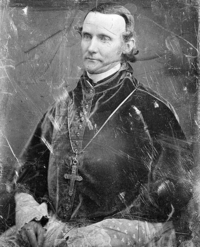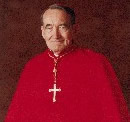Spotlight Archive
On Saturday, November 20, Pope Benedict XVI formally installed 24 new cardinals, among them two Americans, Raymond Burke and Donald Wuerl. They are but the latest in a long line of distinguished American churchmen who have worn the red hat.
The exact origins of the institution of the cardinalate are lost in the history of the early Church. The first cardinals evolved out of the office of presbyter (priest) in the principal churches of Rome. In the eleventh century, the cardinals were given the responsibility for which they are best known: gathering in conclave to elect the pope. The trappings of the honor have come to include the consistory (the ceremony at which the pope installs new cardinals); the "red hat" (to designate the zuchetto bestowed on cardinals during the consistory); and the rest of the scarlet garments, whose shade has varied through the centuries (thus "raised to the purple," from when that costly dye was the favored hue).
The first American bishop to be named a cardinal was not an American bishop at the time. Frenchman Jean Cheverus immigrated to Boston in 1796 in response to a desperate call for more priests. In fact, so many French priests offered their services to the United States (in part due to persecution following the French Revolution) that the percentage of French bishops in the early American Church far exceeded the percentage of ethnic French Catholics in general. Cheverus was one: He was appointed the first bishop of Boston after it was made a diocese in 1808. The Holy Father sent him back to France in 1823 to serve as bishop of Montauban; he was given the red hat in 1836 and died five months later.
 Thus John McCloskey is normally considered the first American cardinal. Born in Brooklyn, McCloskey served as bishop of Albany before being appointed archbishop of New York in 1865. He was raised to the purple in 1875.
Thus John McCloskey is normally considered the first American cardinal. Born in Brooklyn, McCloskey served as bishop of Albany before being appointed archbishop of New York in 1865. He was raised to the purple in 1875.
Every archbishop of New York after McCloskey would find his way onto the pope’s consistory list, with the exception of McCloskey’s immediate successor, Michael Corrigan. In the United States as elswhere in the world, certain dioceses came to be considered preeminent, usually for a combination of historical importance and sheer size. The heads of these sees were customarily made cardinals. Four of the first five dioceses in the nation are included in this number: Baltimore, Philadelphia, Boston, and New York.
Baltimore’s first cardinal was the country’s second: James Gibbons, a leading figure in American public life during his tenure as archbishop (1877–1921). Gibbons was the first American to participate in a conclave, the election of Pope Piux X in 1903. Philadelphia’s first cardinal was Dennis Dougherty, so designated in the year Gibbons died. In 1911, seventy-five years after Jean Cheverus obtained the red hat, Boston’s Archbishop William O’Connell was named cardinal.
As the nation moved west, new centers of Catholic population and influence sprang up. Magnets for Catholic immigrants, the Great Lakes cities of Detroit and Chicago swelled in the late nineteenth and early twentieth centuries. Chicago became the first diocese west of the Mississippi to gain a cardinalate when its archbishop George Mundelein was named in 1924; Detroit’s Edward Mooney entered the college of cardinals in 1946. Cardinal Joseph Glennon was included in the same consistory, but he died before he was able to return home to the archdiocese of St. Louis.
On the west coast, the archdiocese of Los Angeles gradually grew into the largest in the country. Archbishop James McIntyre was named its first cardinal in 1953; all of his successors have likewise achieved the rank. The shift of Catholic population to the south and west was more recently confirmed by the designation of the archbishop of Galveston-Houston, Daniel DiNardo, as cardinal in 2007. Even farther south, the head of the oldest diocese in United States territory, Luis Apunte Martinez of San Juan, Puerto Rico, had become a cardinal in 1973.
As the United States’ bicentennial celebration approached, there was one notable gap in the ranks of American cardinals. In contrast with most other nations, the United States did not choose one of its principal cities to be its capital. As a result, Washington did not even have its own diocese until 1965. In 1976, William Baum was granted the red hat, placing a cardinal at last in the capital of the most powerful nation on earth.
There is another path to the rank of cardinal other than governing an important diocese, and a number of Americans have taken it. Priests who become heads of the major offices (dicasteries) are customarily given red hats as well. Pennsylvania native Francis Brennan was the first curial cardinal from the United States; he was serving as Dean of the Roman Rota when he was named in 1967. John Wright was made cardinal two years later, shortly after his accession to the prefecture of the Congregation for the Clergy. Pope Paul VI made these two appointments. He also made an important change in the rules governing the cardinals’ most important function: Henceforth, cardinals aged 80 or over would not be eligible to vote in papal elections.
Former archbishop of Denver Francis Stafford was President of the Pontifical Council for the Laity when he was made cardinal in 1998. He equaled the highest rank attained by an American prelate when he was appointed head of the Apostolic Penitentiary (a post previously held by William Baum after his tenure in Washington). Cardinal Raymond Burke ascended even higher when he was selected as Prefect for the Apostolic Signatura.
 These are the customary avenues to the cardinalate, but popes may choose to honor priests and bishops with the title for whatever reason they wish. Milwaukee native Aloysius Muench was rewarded with a cardinalate in 1959 after working as nuncio to Germany during the 1950s. Avery Dulles became the first American to become cardinal on the strength of his theological scholarship when John Paul II named him in 2001.
These are the customary avenues to the cardinalate, but popes may choose to honor priests and bishops with the title for whatever reason they wish. Milwaukee native Aloysius Muench was rewarded with a cardinalate in 1959 after working as nuncio to Germany during the 1950s. Avery Dulles became the first American to become cardinal on the strength of his theological scholarship when John Paul II named him in 2001.
A final group of cardinals whose influence on the United States should be noted are the pope’s diplomatic representatives, apostolic delegates and nuncios. Francesco Satolli was the first delegate, whose appointment in 1893 was greeted with dismay by some non-Catholic Americans who feared papal influence. Satolli and nearly all of his successors were raised to the cardinalate after their service in America, including the first nuncio, Pio Laghi, whose status was elevated when the U.S. established full diplomatic relations with the Holy See in 1984.
To say that the diocesan heads, Vatican officials, scholars, and diplomats who have gained the title cardinal are some of the most influential religious figures in the nation’s history is to state the obvious. The one milestone none of them has reached, however, is to be the first American to be charged by his fellow cardinals with headship of the Roman Catholic Church. Whether that historic event ever occurs remains to be seen.
©2010 CatholicHistory.net. Posted November 27, 2010.
Photos, from top: courtesy of Cardinal John McCloskey, courtesy of Old Pictures; Cardinal Avery Dulles.
Sources and Further Reading
The Cardinals of the Holy Roman Church by Salvador Miranda
"Cardinals in the American Church," by Gerald P. Fogarty, SJ, in The Encyclopedia of American Catholic History
